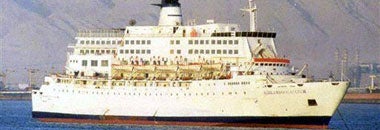Fears for 1,200 as Egyptian ferry sinks

Your support helps us to tell the story
From reproductive rights to climate change to Big Tech, The Independent is on the ground when the story is developing. Whether it's investigating the financials of Elon Musk's pro-Trump PAC or producing our latest documentary, 'The A Word', which shines a light on the American women fighting for reproductive rights, we know how important it is to parse out the facts from the messaging.
At such a critical moment in US history, we need reporters on the ground. Your donation allows us to keep sending journalists to speak to both sides of the story.
The Independent is trusted by Americans across the entire political spectrum. And unlike many other quality news outlets, we choose not to lock Americans out of our reporting and analysis with paywalls. We believe quality journalism should be available to everyone, paid for by those who can afford it.
Your support makes all the difference.An Egyptian passenger ferry carrying around 1,400 people, mostly Egyptian workers returning from Saudi Arabia, sank in the Red Sea overnight.
Coast Guard vessels pulled dozens of bodies from the water today and rescued about 180 survivors from lifeboats, officials said.
The 35-year-old ship Al Salam Boccaccio 98 went down 40 miles off the Egyptian port of Hurghada between midnight and 2am as most of the passengers were sleeping, plunging them into waters whose temperatures average in the upper 60s Fahrenheit (around 19 Celsius) in February.
The cause was not immediately known, but there were high winds and a sandstorm overnight on Saudi Arabia's west coast, from which the ship departed yesterday evening.
"It's a roll-on, roll-off ferry and there is big question mark over the stability of this kind of ship," said David Osler of the London shipping paper Lloyds List. "It would only take a bit of water to get on board this ship and it would be all over ... "The percentage of this type of ferry involved in this type of disaster is huge."
The agent for the ship in Saudi Arabia, Farid al-Douadi, said there were around 220 vehicles on board and that the ship had the capacity for 2,500 passengers.
Four Egyptian rescue ships reached the scene this afternoon, about 10 hours after the ship likely went down, sending passengers into Red Sea waters.
An official at the Maritime Authority control room in Suez confirmed that 20 bodies had been pulled out of the water so far. He said about 100 survivors were rescued from five lifeboats.
A spokesman for the Egyptian Embassy in London, Ayman al-Kaffas, said " dozens of bodies" had been pulled out of the water and several life boats had been spotted.
The ship left at 7pm local time yesterday from the Saudi port of Duba, a common transit point for tens of thousands of Egyptian expatriates working in Saudi Arabia - many of them impoverished - to return home.
The Salam 98's passengers included about 1,200 Egyptians, as well as 99 Saudis, three Syrians, two Sudanese, and a Canadian, the control room official said. Among the passengers were likely Muslim pilgrims who had overstayed their visas after last month's hajj pilgrimage to work in the kingdom.
It was destined for Safaga, a port 120 miles across the Red Sea, from which workers pass on to their homes, mostly in southern Egypt.
No distress signal was received from the ferry, but at some point during the night it disappeared from radar screens, the control room official said. He estimated it went down sometime between midnight and 2am.
Britain diverted a warship, HMS Bulwark, to the scene. Sir Alan West, first sea lord, said the assault ship would arrive in 36 hours.
In Bahrain, the US 5th Fleet said Egyptian authorities had turned down an offer by the Americans to divert a US P3-Orion maritime naval patrol aircraft to the area where the boat went down.
The Al Salaam Boccaccio 98 had a maximum capacity of 2,500 passengers, al-Douadi said. It was carrying 1,318 people, including a crew of 96, the head of the Egyptian Maritime Authority, Mahfouz Taha Marzouk, told The Associated Press.
"The ship complied with all necessary safety measures," Egyptian Transport Minister Mohammed Lutfy Mansour told Egypt's semi-official Middle East News Agency. "The reasons (for sinking) remain unknown."
Marzouk said the ship was built in 1971 and renovated in 1990 in an Egyptian shipyard.
Osler of Lloyds List said that last June the ship passed a structural survey test conducted by the International Safety Management Code.
While the ship's owners and the maritime authority referred to the ship as "Salam 98," Osler said its registered name was Al-Salam Boccaccio 98.
Dubah and Safaga lie virtually opposite each other at the northern end of the Red Sea, which is an extremely busy sea route, with east-west traffic between Saudi Arabia and Egypt as well north-south traffic through the Suez Canal and to and from the Israeli and Jordanian ports of Eilat and Aqaba.
The ship is owned by the Egyptian firm El Salam Maritime Transport Company. The company's owner, Mamdouh Ismail, said the ship is registered in Panama. He spoke before the sinking was confirmed and refused to comment further.
A ship owned by the same company, also carrying pilgrims, collided with a cargo ship at the southern entrance to the Suez Canal in October, causing a stampede among passengers trying to escape the sinking ship. Two people were killed and 40 injured.
Join our commenting forum
Join thought-provoking conversations, follow other Independent readers and see their replies
Comments